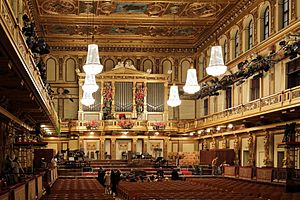New Year's Day facts for kids
Quick facts for kids New Year's Day |
|
|---|---|

Fireworks in Mexico City for the Celebration of the New Year in 2013
|
|
| Observed by | Users of the Gregorian calendar |
| Type | International |
| Significance | The first day of the year in the Gregorian calendar |
| Celebrations | Making New Year's resolutions, church services, parades, parties, sporting events, fireworks, drone light shows |
| Date | 1 January |
| Next time | 1 January 2026 |
| Frequency | Annual |
| Related to |
|
New Year's Day is a special holiday celebrated around the world. It marks the very first day of the new calendar year, which is always January 1st in the Gregorian calendar. This calendar is used by most countries today.
Long ago, in ancient Rome, January 1st was a day to honor Janus. He was the Roman god of beginnings and gateways. That's why the month of January is named after him! For a long time, different parts of Europe celebrated the New Year on different dates. Some celebrated on December 25th, others on March 1st, or even on Easter.
Today, January 1st is one of the most popular public holidays worldwide. People often celebrate with amazing fireworks when the clock strikes midnight on New Year's Eve. This happens as the new year begins in each time zone. Many people also make New Year's resolutions, which are promises to themselves for the year ahead. It's also a time to call friends and family to wish them well.
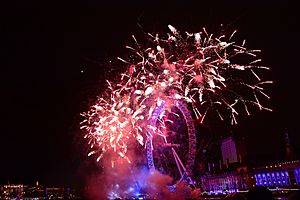

Contents
Celebrating the New Year Around the World
While many countries celebrate New Year's Day on January 1st, different cultures and religions have their own special New Year celebrations throughout the year. These dates are often based on different types of calendars, like the lunisolar calendar which follows both the moon and the sun.
Here are some examples of other New Year celebrations:
- The Eastern Orthodox New Year is celebrated on January 14th.
- The Chinese New Year (also called Lunar New Year) usually falls in late January or February.
- The Iranian New Year, called Norouz, happens around March 20th or 21st. This is the exact moment of the spring equinox.
- The Bahá'í New Year, Naw-Rúz, also takes place around the spring equinox.
- Many New Year celebrations in India and Southeast Asia, like the Tamil and Thai New Years, happen in April.
- The Islamic New Year is celebrated on the 1st of Muharram, which changes each year on the Gregorian calendar.
New Year's Eve Traditions
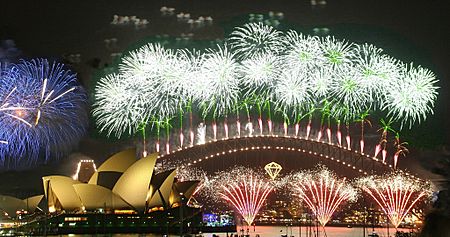
New Year's Eve is the night of December 31st, right before New Year's Day. It's a time to look back at the past year and get ready for the new one. Many newspapers and TV shows review the big events of the year.
This night is often a time for big parties and public celebrations. Many cities have huge fireworks shows as the clock counts down to midnight. Some people also attend special church services called Watchnight services.
New Year's Day Fun and Customs
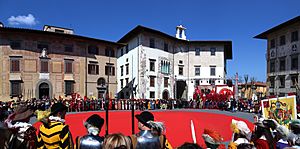
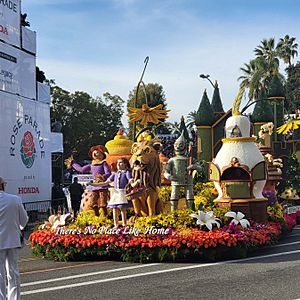
On January 1st, many exciting events and traditions take place around the world:
- Parades: Several big parades are held, like the London's New Year's Day Parade and the Tournament of Roses Parade in Pasadena, California.
- First Day Hikes: In the United States, many state parks offer "First Day Hikes." People start the new year by enjoying nature.
- Concerts: The Vienna Philharmonic orchestra in Austria performs a famous Vienna New Year's Concert every year.
- Polar Bear Plunges: In some cold places, people jump into icy water! These "polar bear plunges" are often done to raise money for charity.
- Irish Traditions: In Ireland, New Year's Day was once called Lá na gCeapairí, or "the day of the buttered bread." People would put buttered bread on their doorstep to wish for good food in the coming year.
- First Sunrise: In Japan, Korea, and parts of the Arctic, watching the first sunrise of the new year is a special tradition.
- Sports Events: New Year's Day is a big day for sports. In the United States, major college football games are played. The National Hockey League also hosts an outdoor game called the Winter Classic. In England, the Premier League has many football matches.
- Lucky Foods: In the Southern United States, people eat special foods like Hoppin' John (black-eyed peas and rice) and collard greens. These foods are believed to bring good luck and money in the new year.
Music for the New Year
Music plays a big part in New Year's celebrations. There are many classical and popular songs about the new year.
- A famous hymn for the new year is "Nun lasst uns gehn und treten" from 1653.
- The composer Johann Sebastian Bach wrote three special pieces for the new year for the organ.
- In English-speaking countries, it's a tradition to sing "Auld Lang Syne" at midnight on New Year's Eve.
New Year Babies
You might see cartoons of an old man, Father Time, passing his duties to a cute baby, the Baby New Year. This shows the old year ending and the new year beginning.
Babies born on New Year's Day are often called New Year babies. Hospitals sometimes give prizes to the first baby born in the new year. These gifts can include baby formula, blankets, and gift cards.
Antarctica's Moving Pole
On New Year's Day in Antarctica, something unique happens. The marker for the geographic South Pole is moved about 10 meters. This is because the ice sheet it sits on is always moving! A new marker is designed and placed each year by the staff working there.
Images for kids
See also
 In Spanish: Día de Año Nuevo para niños
In Spanish: Día de Año Nuevo para niños
- First Night
- Rosh Hashanah


